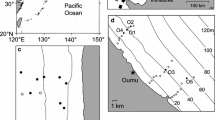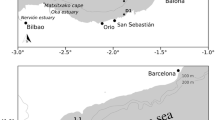Abstract
We studied the diet of larval and juvenile Japanese anchovy Engraulis japonicus in the upper Ariake Bay, Japan. Diet was analyzed by examining the digestive tracts; feeding intensity, proportion of empty guts, and prey selectivity were calculated. Anchovy density was negatively influenced by temperature and positively by salinity and prey density. Diet was dominated by Acartia omorii, which was positively selected with two other copepods, Calanus sinicus and Pseudodiaptomus marinus. In contrast, Oithona davisae was highly dominant in the environment but was absent in anchovy guts; thus, this copepod was negatively selected, with two others, Tortanus derjugini and Sinocalanus sinensis. Overall, larger prey were positively selected and smaller ones were negatively selected; value of electivity index correlated negatively with prey size. Larvae [<18 mm of standard length (SL)] showed significantly lower feeding intensities and higher rates of empty guts than juveniles (≥18 mm SL). In juveniles, feeding intensity increased steadily as the fish grew in size, with a corresponding reduction in empty guts. Feeding intensity correlated positively and empty gut correlated negatively with fish size. We suggest that larger prey are important diets for postlarval Japanese anchovy in Ariake Bay.






Similar content being viewed by others
References
Aoki I, Miyashita K (2000) Dispersal of larvae and juveniles of Japanese anchovy Engraulis japonicus in the Kuroshio Extension and Kuroshio–Oyashio transition regions, western North Pacific Ocean. Fish Res 49:155–164. doi:10.1016/S0165-7836(00)00197-1
Arthur DK (1976) Food and feeding of larvae of three fishes occurring in the California Current, Sardinops sagax, Engraulis mordax and Trachurus symmetricus. Fish Bull (Wash D C) 74:517–530
Bulgakova YV (1996) Feeding in the Black Sea anchovy: diet composition, feeding behaviour, feeding periodicity and daily rations. Sci Mar 60 (Suppl 2):283–284
Chen CS, Chiu TS (2003) Early life history traits of Japanese anchovy in the northeastern waters of Taiwan, with reference to larval transport. Zool Stud 42:248–257
Conway DVP, Coombs SH, Smith C (1998) Feeding of anchovy Engraulis encrasicolus larvae in the northwestern Adriatic Sea in response to changing hydrobiological conditions. Mar Ecol Prog Ser 175:35–49. doi:10.3354/meps175035
Forward RB Jr, Tankersley RA (2001) Selective tidal-stream transport of marine animals. Oceanogr Mar Biol Ann Rev 39:305–353
Fukuhara O (1983) Development and growth of laboratory reared Engraulis japonica (Houttuyn) larvae. J Fish Biol 23:641–652. doi:10.1111/j.1095-8649.1983.tb02943.x
Gill AB (2003) The dynamics of prey choice in fish: the importance of prey size and satiation. J Fish Biol 63(Suppl A):105–116. doi:10.1111/j.1095-8649.2003.00214.x
Honda H, Kan-no M (1997) Size selective feeding and its limitations for the black rockfish, Sebastes inermis, in a demersal fish assemblage of Onagawa Bay, Northeastern Japan. Environ Biol Fishes 50:183–193. doi:10.1023/A:1007331501193
Houde ED (1997) Patterns and trends in larval-stage growth and mortality of teleost fish. J Fish Biol 51:52–83. doi:10.1111/j.1095-8649.1997.tb06093.x
Hovenkamp F (1992) Growth-dependent mortality of larval plaice Pleuronectes platessa in the North Sea. Mar Ecol Prog Ser 82:95–101. doi:10.3354/meps082095
Islam MS, Tanaka M (2006) Ontogenetic diet shift during larva-juvenile transition in Japanese sea bass Lateolabrax japonicus in Ariake Bay, Japan. Mar Ecol Prog Ser 323:305–310. doi:10.3354/meps323305
Islam MS, Hibino M, Tanaka M (2006a) Distribution and diets of larval and juvenile fishes: influence of salinity gradient and turbidity maximum in a temperate estuary in upper Ariake Bay, Japan. Estuar Coast Shelf Sci 68:62–74. doi:10.1016/j.ecss.2006.01.010
Islam MS, Ueda H, Tanaka M (2006b) Spatial and seasonal variations in copepod communities related to turbidity maximum along the Chikugo estuarine gradient in the upper Ariake Bay, Japan. Estuar Coast Shelf Sci 68:113–126. doi:10.1016/j.ecss.2006.02.002
Meekan MG, Fortier L (1996) Selection for fast growth during the larval life of Atlantic cod Gadus morhua on the Scotian Shelf. Mar Ecol Prog Ser 137:25–37. doi:10.3354/meps137025
Meekan MG, Vigliola L, Hansen A, Doherty PJ, Halford A, Carleton JH (2006) Bigger is better: size-selective mortality throughout the life history of a fast-growing clupeid, Spratelloides gracilis. Mar Ecol Prog Ser 317:237–244. doi:10.3354/meps317237
Mitani I (1987) Environmental correspondence between shirasu and food organisms in shirasu fishing ground. Bull Jpn Soc Fish Oceanogr 51:46–51
Odate S (1957) Studies on the larval fish of the Japanese anchovy, Engraulis japonica, in the northeastern sea area of Japan. Bull Tohoku Reg Fish Res Lab 9:111–128
Pepin P, Penney RW (1997) Patterns of prey size and taxonomic composition in larval fish: are there general size dependent models? J Fish Biol 51(Suppl A):84–100. doi:10.1111/j.1095-8649.1997.tb06094.x
Pyke GH (1984) Optimal foraging theory: a critical review. Annu Rev Ecol Syst 15:523–575. doi:10.1146/annurev.es.15.110184.002515
Qin JG, Hillier T (2000) Live food and feeding ecology of larval snapper (Pagrus auratus). In: McKinnon et al (eds) Proceedings of a workshop on hatchery feeds, Cairns, 9–10 March 2000. Hatchery Feeds, pp 63–68
Rice JA, Crowder LB, Rose KA (1993) Interactions between size-structured predator and prey populations: experimental test and model comparison. Trans Am Fish Soc 122:481–491. doi :10.1577/1548-8659(1993)122<0481:IBSSPA>2.3.CO;2
Sogard SM (1997) Size-selective mortality in the juvenile stage of teleost fishes: a review. Bull Mar Sci 60:1129–1157
Takahashi M, Watanabe Y (2004a) Developmental and growth rates of Japanese anchovy Engraulis japonicus during metamorphosis in the Kuroshio–Oyashio transitional waters. Mar Ecol Prog Ser 282:253–260. doi:10.3354/meps282253
Takahashi M, Watanabe Y (2004b) Growth rate-dependent recruitment of Japanese anchovy Engraulis japonicus in the Kuroshio–Oyashio transitional waters. Mar Ecol Prog Ser 266:227–238
Takahashi M, Watanabe Y (2005) Effects of temperature and food availability on growth rate during late larval stage of Japanese anchovy (Engraulis japonicus) in the Kuroshio–Oyashio transition region. Fish Oceanogr 14:223–235. doi:10.1111/j.1365-2419.2005.00334.x
Takahashi M, Watanabe Y, Kinoshita T, Watanabe C (2001) Growth of larval and early juvenile Japanese anchovy, Engraulis japonicus, in the Kuroshio–Oyashio transition region. Fish Oceanogr 10:235–247. doi:10.1046/j.1365-2419.2001.00160.x
Takasuka A, Aoki I (2002) Growth rates of larval stage of Japanese anchovy Engraulis japonicus and environmental factors in the Kuroshio Extension and Kuroshio–Oyashio transition regions, western North Pacific Ocean. Fish Sci 68(Supplement I):445–446
Takasuka A, Aoki I (2006) Environmental determinants of growth rates for larval Japanese anchovy Engraulis japonicus in different waters. Fish Oceanogr 15:139–149. doi:10.1111/j.1365-2419.2005.00385.x
Takasuka A, Aoki I, Mitani I (2003) Evidence of growth-selective predation on larval Japanese anchovy Engraulis japonicus in Sagami Bay. Mar Ecol Prog Ser 252:223–238. doi:10.3354/meps252223
Takasuka A, Aoki I, Mitani I (2004) Three synergistic growth-related mechanisms in the short-term survival of larval Japanese anchovy Engraulis japonicus in Sagami Bay. Mar Ecol Prog Ser 270:217–228. doi:10.3354/meps270217
Takasuka A, Aoki I, Oozeki Y (2007) Predator-specific growth-selective predation on larval Japanese anchovy Engraulis japonicus. Mar Ecol Prog Ser 350:99–107. doi:10.3354/meps07158
Tudela S, Palomera I, Quilez G (2002) Feeding of anchovy Engraulis encrasicolus larvae in the north-west Mediterranean. J Mar Biol Assoc UK 82:349–350. doi:10.1017/S0025315402005568
Ueda H, Terao A, Tanaka M, Hibino M, Islam MS (2004) How can river-estuarine planktonic copepods survive river floods? Ecol Res 19:625–632. doi:10.1111/j.1440-1703.2004.00677.x
Uotani I (1985a) The relation between feeding mode and feeding habit of the anchovy larvae. Bull Jpn Soc Sci Fish 51:1057–1065
Uotani I (1985b) The relation between the development of feeding organs and feeding modes of the anchovy larvae. Bull Jpn Soc Sci Fish 51:197–204
Uotani I, Fukui A, Kobayashi H, Saito H, Kawaguchi K (2000) The intensity of scattered light in turbid seawater is a major factor in the turbiditaxis of Japanese anchovy larvae. Fish Sci 66:294–298. doi:10.1046/j.1444-2906.2000.00046.x
Vigliola L, Meekan MG (2002) Size at hatching and planktonic growth determines post-settlement survivorship of a coral reef fish. Oecologia 131:89–93. doi:10.1007/s00442-001-0866-4
Viitasalo M, Flinkman J, Viheluoto M (2001) Zooplanktivory in the Baltic Sea: a comparison of prey selectivity by Clupea harengus and Mysis mixta, with reference to prey escape reactions. Mar Ecol Prog Ser 216:191–200. doi:10.3354/meps216191
Werner EE, Hall DJ (1974) Optimal foraging and the size selection of prey by the bluegill sunfish (Lepomis macrochirus). Ecology 55:1042–1052. doi:10.2307/1940354
Wootton RJ (1998) Ecology of teleost fishes, 2nd edn. Kluwer Academic Publisher, Dordrecht
Acknowledgements
This research was supported by the research grant provided by the Japanese Government Ministry of Education, Culture, Sports, Science and Technology (Monbukagakusho, MEXT); the first author acknowledges financial support provided by the MEXT (through Monbukagakusho Scholarship) during his stay in Japan. We thankfully acknowledge the comments of the anonymous reviewers, which tremendously improved the manuscript.
Author information
Authors and Affiliations
Corresponding author
Rights and permissions
About this article
Cite this article
Islam, M.S., Tanaka, M. Diet and prey selection in larval and juvenile Japanese anchovy Engraulis japonicus in Ariake Bay, Japan. Aquat Ecol 43, 549–558 (2009). https://doi.org/10.1007/s10452-008-9207-6
Received:
Accepted:
Published:
Issue Date:
DOI: https://doi.org/10.1007/s10452-008-9207-6




